Rhode Island Wetlands
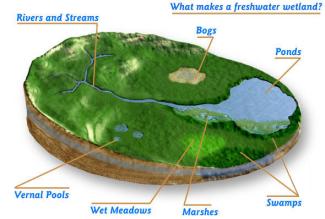
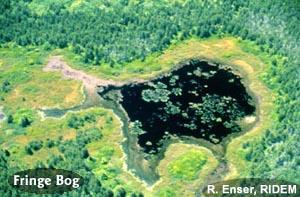
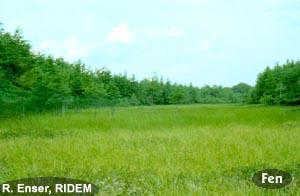
Bogs are relatively uncommon in Rhode Island. They are distinguished by floating mats of Sphagnum (Sphagnum sp.) moss that "quake" when walked upon.
Bogs form in isolated depressions that continuously hold water, or as fringes along the shores of ponds. Due to the constant presence of water dead plants are not able to decay and plant fibers accumulate as "peat" which becomes thicker over time, hence filling the basin and providing the base for the quaking mat. The constant saturated condition of the peat creates an environment that is difficult for plants to grow in. Trees, such as cedar or spruce, growing on the edges of bogs, may be dwarfed from the wet, low nutrient environment. Pitcher plants (Sarracenia purpurea) and sundews (Drosera) are examples of plants with special adaptations for survival in the harsh bog environment. They are carnivorous and are able to trap and digest insects to obtain necessary minerals missing from the soil. Other plants commonly found in bogs include blueberry (Vaccinium corybosum), leather leaf (Chamaedaphne thyoides), sweet gale (Myrica gale) and Cranberry (Vaccinium sp.).
Fens differ from bogs in that they have very little Sphagnum moss and they may be seasonally flooded.
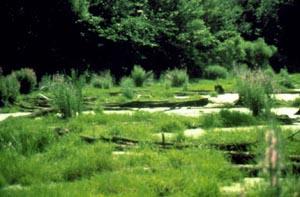

Marshes, one of the most easily recognized freshwater wetlands, are commonly found along lake and pond shores, and river edges. The depth and duration of surface water in a marsh varies; some marshes may be flooded seasonally, while others may have permanent surface water. Common marsh plants include sedges (Carex sp.), cattails (Typha sp.), rushes (Juncus sp.), and flowering herbs such as pickerelweed (Pontederia cordata) and arrowhead (Sagittaria sp.)
Marshes provide valuable habitat for wildlife that use marshes for breeding, nursery grounds, feeding, and resting sites. Marshes can also improve water quality by filtering excess nutrients, sediment, and pollutants out of the surface water.
Rhode Island's landscape includes hundreds of freshwater lakes and ponds covering 20,749 acres (mapped at 1:24000). Named as ponds, lakes or reservoirs, these waterbodies provide multiple recreational opportunities, important aquatic habitat, and a reliable source of drinking water supply for a majority of Rhode Island residents.
Freshwater Lakes, Ponds and Reservoirs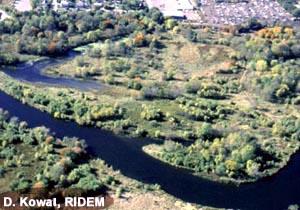
Rivers and streams are common, easily identified habitats characterized by channelized, flowing water. Channels can be wide or narrow, deep or shallow, with sandy, muddy, or rocky bottoms depending upon their origin and the rate and volume of water flow in the channel. Rivers and streams can have perennial year round flow or intermittent flow usually during the wettest seasons. Water flow can be swift or slow moving.
Rivers and streams provide very important connections between vegetated wetlands for water flow and aquatic wildlife travel. They are also highly valued recreational areas.
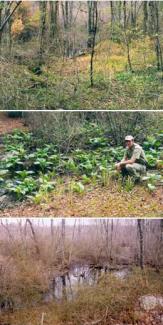
Swamps are the most common wetland type in Rhode Island. They are dominated by trees or shrubs and can be located along rivers or streams, along pond shorelines, in isolated settings, or on hillside slopes. Swamps are not always obviously wet and are therefore not always easy to identify. Some swamps have surface water during the spring months and are dry by summer. Many swamps never flood, but have water near or just below the ground surface. The soil can be saturated and mucky if the swamp is wet enough, but it will not necessarily be so in a swamp that never has surface water.
The most common tree in Rhode Island's swamps is red maple (Acer rubrum). We also have swamps dominated by Atlantic white cedar (Chamaecyparis thyoides) trees. Common swamp shrubs include blueberry (Vaccinium corybosum), sweet pepperbush (Clethra alnifolia), swamp azalea (Rhododendron viscosum), and spicebush (Lindera benzoin). Common herbaceous plants, that grow in the understory of swamps include cinnamon fern (Osmunda cinnamomea), skunk cabbage (Symplocarpus foetidus), and sphagnum (Sphagnum sp.) moss.
Images Anne Jett, NEIWPCC
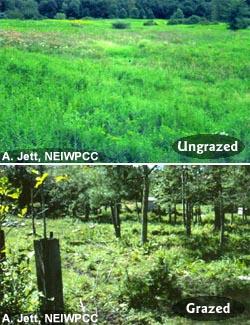
Wet meadows are "wet" fields that are generally firm underfoot and at times may not appear to be wetlands at all. Wet meadows represent a small percentage of Rhode Island's freshwater wetlands. They may be seasonally flooded or saturated to the ground surface.
The most common plants found in wet meadows include sedges, grasses, rushes, & flowering herbs. In agricultural areas of Rhode Island, many wet meadows occupy areas that were once swamps. During colonial times, the forests were cleared for pastures. Since these areas were too wet to grow crops, the farmers used them as grazing areas for livestock. Because of the continual grazing, these areas have not reverted back to swamp, but remain as wet "fields" or meadows.
Wet meadows are generally short-lived, unless some sort of disturbance maintains them, i.e. grazing, fire, mowing or cutting woody vegetation.
